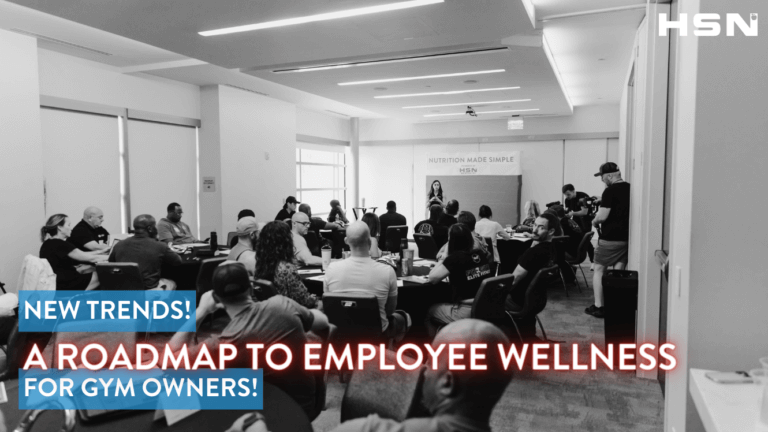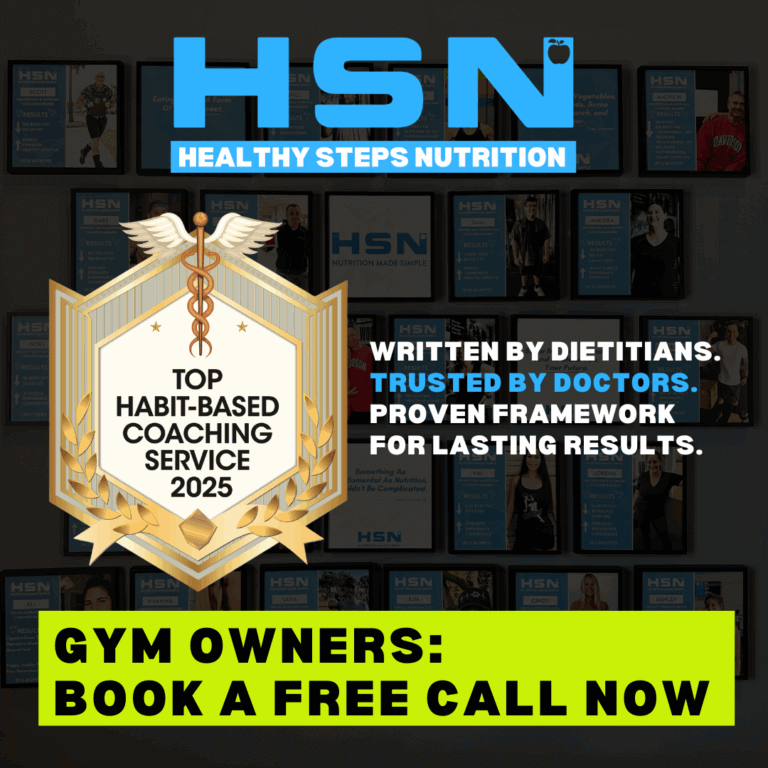As gym owners we all have a passion for health and wellness fully believing that exercise and nutrition are the foundation for living a long healthy life. A great way to get outside the walls of your gym and reach a wider audience is by developing an employee wellness program.
In past years at Healthy Steps Nutrition, many employers hiring us for employee wellness initiatives wanted our full focus on nutrition. We love this focus because we all know, there is so much misinformation out there about nutrition. And, the opportunity to provide educational resources, and in person accountability to a lot of people at once makes our mouths water (no pun intended).
This being said, in recent months the landscape of employee wellness is undergoing a significant shift. While a focus on healthy eating was once a common approach, and still very important, companies are now recognizing the importance of offering a holistic approach to wellness. This is reflected in a surge in investment, with 44% of companies planning to increase their wellness budgets in 2024 and another 51% maintaining their current investment.
The priorities have also changed dramatically. Mental health (91%), stress management (66%), telemedicine access (65%), and mindfulness training (55%) are now the top benefits employers are seeking to provide. This is accompanied by a decrease in investment in more traditional offerings like smoking cessation programs, on-site fitness classes (59% decrease), biometric screenings (46% decrease), health fairs (33% decrease), and on-demand fitness options (32% decrease).
These trends signal a clear move towards a more comprehensive approach to employee well-being, focusing on mental and emotional health alongside physical wellness.
Why Employee Wellness Programs Matter
In today’s competitive job market, employee wellness programs are no longer a perk, but a powerful tool for attracting and retaining top talent. These programs have the potential to go beyond just gym memberships, and biometric screenings offering a holistic approach to employee well-being that boosts morale, reduces absenteeism, and fosters a culture of engagement.
By taking into consideration a more holistic approach, companies are not only creating a happier and healthier workforce but also reaping significant benefits in terms of productivity and bottom-line results.
Benefits of Employee Wellness Programs
Workplace wellness programs need to provide benefits for both the employer and the employee.

Promote and improve overall health and well-being
Employee wellness programs can improve employee physical and mental health, leading to a healthier and more productive workforce. Wellness programs can also reduce healthcare costs and improve employee morale and job satisfaction.
Provide an offering that isn't hard to implement and is easy to administer for the employer
Employers don’t want a program that is challenging to implement. They want ease of use and something with a low barrier to entry for employees.
Increase employee engagement
Wellness programs can increase employee engagement and productivity, leading to improved job satisfaction and reduced turnover. Healthy employees are more likely to be motivated and focused, leading to improved performance and productivity. A study by the Society for Human Resource Management (SHRM) found that companies that invested in employee well-being programs saw an average productivity increase of 8%.
Having a wellness program that is innovative & fun keeps employees’ attention. By applying lessons and challenges to real-life scenarios employees can actually take what they learn and apply it in their life.
Improve employee retention and recruitment
Wellness programs can improve employee retention and recruitment, leading to reduced turnover and improved talent attraction. Employers that offer wellness programs are seen as caring about their employees’ health and well-being, improving their reputation and attractiveness to top talent. Such programs need to provide employees with more than just the traditional incentive programs and health risk assessments. Mental health resources need to be included.
Enhance company culture and reputation
Wellness programs can enhance company culture and reputation, leading to improved employee morale and job satisfaction. Employers that prioritize employee health and well-being are seen as responsible and caring, improving their reputation and attractiveness to customers and partners.
Reduce absenteeism and presenteeism
Wellness programs can reduce absenteeism, leading to improved employee availability and reduced costs. Healthy employees are less likely to need time off for illness or injury, reducing the impact of absenteeism on the organization.
Lower health care costs
Wellness programs can reduce healthcare costs by promoting healthy behaviors, discouraging poor health behaviors, and reducing the risk of chronic diseases. Employers can also reduce costs associated with absenteeism.

What Does This Mean For Gym Owners & Nutrition Coaches
If you are a member of HSN Mentoring it means that you have an amazing opportunity to not only help the members of your gym but to offer employee wellness in your community using the resources we provide you to run a comprehensive wellness program.
Your program should highlight a holistic appr
A well-rounded program doesn’t only focus on weight loss but rather utilizes the HSN Framework to address:
Sleep
Stress management
Nutrition
Exercise
Social Circle
Lifestyle
There are so many factors that play into nutrition choices. Addressing only nutrition is short-sided.

Offerings shouldn't require people to go to your gym or workout
The gym is awesome, but not everyone loves CrossFit or sweating like we do. Reduce the barrier to entry and make it easy for employers to get employees to engage in the program.
Fun and engaging
We’ve all been part of the wellness offerings that are boring and lack the requirement of action. As small businesses, we are able to customize our program making it more enticing than the traditional employee wellness program. Challenges require action. If employees are taking action, they will get results which makes them happy.
Types of Companies That May Offer Wellness Programs To Employees
Many companies offer wellness initiatives to their employees, however we find there is a certain demographic of employers that are more willing to work with a smaller wellness provider.
We have had great luck with local:
Construction Companies
Banks
Oil Companies
Dental Offices
IT Companies
Charter Schools
Smaller companies have the ability to make decisions locally without having to get approval from multiple tiers of leadership. Additionally, they love to support smaller businesses just like them. Your wellness program is a small business.

3 Types of Employee Wellness Programs To Offer
Offering #1: 6-Week Wellness Challenge
A wellness challenge is a great offering because it requires action, engagement and participation from employees.
Best times of year for wellness challenges
February or September are the best times to offer a challenge. February is when all new years resolutions fail, and September is just after the kids go back to school before the holidays.
Format
Offering a hybrid of in person checkins, zoom call engagement meetings, and in person initial biometrics and kick-off seminar is the gold standard.
Employer Conversations
If you are new to employee wellness finding leads is necessary. In order to launch a new year challenge you will need to begin the initial conversations of offering a challenge by September or October. Marketing for the employer will take place from December through January with a challenge start date of February.
Fall challenge conversations need to start in June with marketing starting in July and running through August. The wellness challenge will start in September.
Offering #2: Ongoing Support After A Challenge
Ongoing support after a challenge is a great way to offer accountability to employees. This can be done through group support on a monthly retainer. Typically we will offer employers the opportunity to participate in a group offering after the challenge to encourage employees to maintain their healthy eating habits, physical well being, and mental health practices.
Monthly support includes:
Group Support & Engagement In The HSN App
Leveraging Our Leaderboard For Monthly Focus & Group Features In The HSN App
Monthly Wellness Tip Emails & VideosOffering #2: Wellness Seminar Series
Offering #3: Seminars or Lunch and Learns
Virtual Or In-Person Seminars are another great way to educate on a holistic approach to wellness. I always love to pair a good in-person wellness seminar with a lunch from one of our healthy meal prep providers.
Top Employee Wellness Seminars include:
Food, Mood & Stress Management
Beginners Guide To Meal Prepping
3 Steps To Reset Your Health Navigating
The All Or Nothing Mindset
Format
In person or virtual nutrition seminars are both valuable. In person provides the opportunity to include local business partners by having them cater a healthy lunch paid for by the company. This is a great way to engage and entertain employees, and also teach them the plate method.
Virtual offers the opportunity for more employees to attend, especially if there are many branches to the company making it so not everyone is local to your location.

Building Momentum For A Wellness Program Challenge Launch
You’ve done the work, set up your offerings, marketing material and pricing. After a company says “YES”, it’s time to get to work!
Let’s say they pick a challenge to start their program off. Now it’s time to market and prep employees for what’s to come.
Spark Leadership Enthusiasm:
The first stop is the leadership team. Secure buy-in from the company leadership team first. Their active participation sets the tone for the entire program. Next you will need to connect directly with employees.
Strategic Marketing is Key:
Early Collaboration: Work with the HR and marketing department early on to develop an engaging communication plan and decide who is sending emails is key.
Targeted Communication: Utilize eye-catching visuals, targeted emails to the entire staff, and even social media promotion to build anticipation before the launch.
A Lunchtime Q&A is also a great way! Host a casual lunchtime session to answer questions and address concerns directly with employees. This has worked very well for us in the past. Additionally offering a Q&A virtually a couple of times before the launch is a nice added benefit.
Empower Employee Champions:
Identify enthusiastic employees who can promote the program to their colleagues and generate excitement. Even offering an incentive for employees who recruit the most coworkers is a fun little challenge.

Launching Your Employee Wellness Program: Key Considerations
Here’s what you need to keep in mind to ensure a successful employee wellness program launch:
Timing is Key: Reminder to consider the best time of year to introduce your program. Late Winter or early Fall can be good options.
Planning and Rollout: Allow for a reasonable timeframe between initial communication and program launch. Aim for 4-6 weeks to generate excitement and answer questions.
Scheduling: Schedule program elements like kick off seminars, in person pre and post challenge meetings need to be at convenient times. Consider offering a variety of options to cater to different work schedules.
Financial Considerations: If running a challenge, determine upfront who will be covering the costs. This could be a combination of company and employee contributions, with a clear breakdown of percentages or specific amounts.
Participation: Participation should be voluntary to encourage a positive experience. Mandatory programs can backfire.
Leadership Engagement: While participation can be voluntary, it’s highly recommended to have leadership actively involved. When leaders participate, it sends a strong message of support and increases employee buy-in.
Focus on Engagement: Engagement is your primary metric. Track participation and satisfaction to demonstrate the program’s effectiveness to the company.
Real Success With Employee Wellness
JKS Construction partnered with Healthy Steps Nutrition to run a six week health and wellness challenge. During this challenge employees worked really hard together to make healthy living a way of their lives.
Employee engagement was high, and the results from several employees were staggering.
Josh Olsen, Director of Finance at JKS lost a total of 102 pounds. He had a mission to improve his physical health and see his daughter walk down the isle one day.
Josh learned some healthy habits when he participated in the first wellness program JKS offered through Healthy Steps Nutrition for their employees.
Healthy Steps Nutrition was invited back for a second initiative and Josh crushed it his second go round.
At his final checkin it was discovered that he lost a total of 102 pounds!
Check out Josh’s story below!
Wrap Up
Now it’s time for you to take action! If you are an HSN Mentoring client and would like to get started with employee wellness, talk to your mentor. But if you are not, it’s not too late! Book a free call with us to see if we are a good fit.
In the mean time, after you have the back end of your program set up, make a list of potential wellness opportunities and begin reaching out to set those formal meetings.





